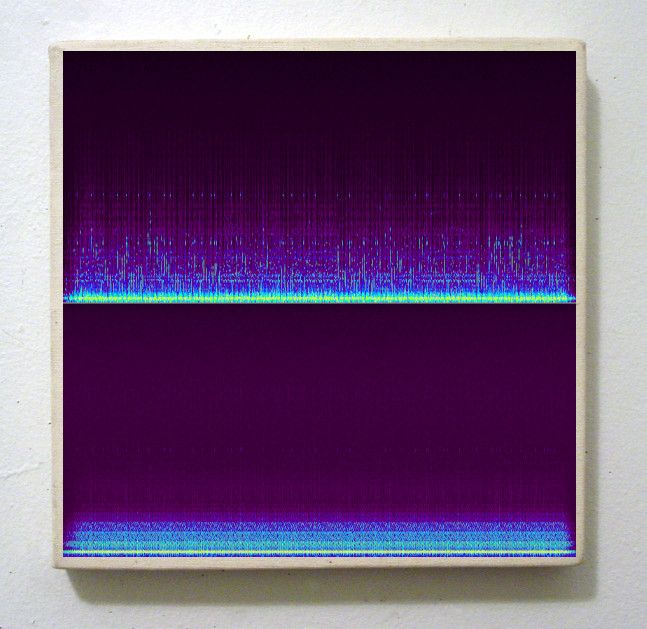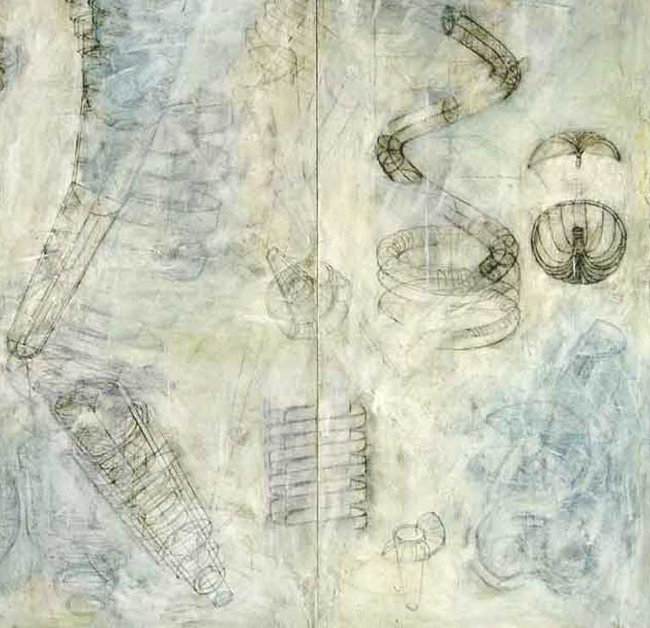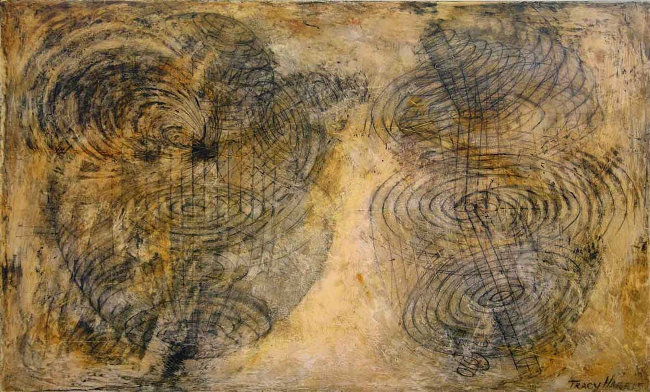
The audio can be heard on Bandcamp.

Tracy Harris, Funnel Made of Wind or Water (detail), oil, wax, graphite on wood, 80 x 108 inches
link to artist's website
At the time I wrote the review below I was covering Texas for Artforum. I had every intention of submitting it to the magazine but didn't. Looking back the writing seems fine so I don't know what I was thinking. I remember an acquaintance (or perhaps another review) saying the work had a "da Vinci's notebooks" vibe and it sort of does but I saw the ideas as more contemporary. The images here come from Harris' website -- they are closest to what I remember of her work in the show.
Tracy Harris
Graham Gallery, Houston, TX
June 8 - July 9, 1991
Abstract painting lends itself to the exploration of ideas suggested by contemporary physics: the interrelatedness of things, the unraveling of cause and effect, the impact of the observer on the observed. Tracy Harris fuses concepts of 20th Century art and science in a quite literal way, by incorporating scientific imagery into the chaotic vocabulary of Abstract Expressionism. On wooden panels, heavily-textured fields of blue-green and beige serve as backgrounds for line drawings suggesting the cryptic notations of engineers, physicists, and industrial designers. Although the schematics hint at specific activities -- plotting black hole coordinates, designing a better teacup -- they seem just as concerned with the roles of choice and chance in the creation of works of art.
Harris pays equal attention to the rendering of figures (predominantly cones, spirals, funnels, and cylinders, varying in size and depth) and the negative spaces surrounding them -- voids of muted color that alternately swirl with gestural life or lapse into states of graceful decay. She restlessly draws, erases, and redraws the figures, leaving ghostly traces as if on palimpsests, and scrapes and scumbles the backgrounds until they attain a comparable degree of surface complexity. Occasionally figures and grounds unite synergistically, as in one untitled panel suggesting a series of mechanical arms spiraling down a cosmic drain, and another in which bowl-shapes progress through stages of Cubistic dismemberment.
It would be tempting to discuss Harris' work purely in formal terms; obviously line quality, balance, and texture are important to the artist, and the images record her struggles to bring these elements to a state of eccentric perfection. Some viewers may see the schematic drawings as abstract motifs or design elements and leave it at that. One writer has called them "iconic," disregarding the patterns of uncertainty and choice implied by the webs of half-erased lines surrounding or connecting objects. It would certainly be farfetched to interpret the panels as Dadaist jeremiads on the mechanization of sex or the dehumanizing effects of technology.
If the diagrammatic shapes were just motifs or static icons, the paintings wouldn't be as compelling as they are. Part of their fascination lies in the success of the artist's research -- her knack for finding utilitarian images that work well as components in imaginative hybrids. In this sense, the shapes become metaphors for the process of invention. Paradoxically, in the course of the artist's self-imposed struggles with the formal aspects of the work, something very unscientific occurs: she invests the shapes with emotional life, making it possible to see them as characters in peculiar contemporary dramas. Chaos theory and the riddles of quantum mechanics obviously figure in these productions; the extent to which they act as plot or scenery is a question bearing further study.

Tracy Harris, Warp and Weft, oil and wax on wood, 34 x 56 inches
link to artist's website
[italicized introduction edited after posting]
Thanks to ffog for inviting me to guest-DJ again on his weekly internet radio show, Myocyte.
The mix was "simulcast" on anonradio and tilderadio, and has been archived by anonradio (scroll down to "Ffog - Pleasure & Discomfort Myocyte"). An mp3 version of the mix is here: [1 hr mp3] (The show was broadcast at 1 am on June 18 UTC, which is 8 pm Central, June 17, in the US.)
While the tracks were playing I "announced" via text chat on the #sally and #tilderadio channels on IRC (Internet Relay Chat). Listeners could comment or ask questions. This is an interesting way to DJ, very different from my old FM radio days and a few steps up aesthetically from having everyone's data and souls leeched out on spotify, etc.
Set list and notes for the show:
Madalyn Merkey - Gypsy Woman (2021) - Standards LP (MIDI versions of rave and techno favorites)
Greg Hawkes - Ants in Your Pants (1983) - Niagara Falls (solo LP by keyboardist for The Cars)
Groenland Orchester - Tonika Oase (2001) - Nurobic LP
I-f - Secret Desire (1999) - The Man from PACK
Rubba - Movement (1982) (library-type music by two ex-Soft Machine members Mike Ratledge & Karl Jenkins)
Atomic Robo Kid - Magical Sound Shower (2000)
DJ Good Groove - Rock It (1998)
Mundo - "Music - The Question" (1998) - (early release by Dallas DJ who later produced dubstep & UK garage)
Mantronix - Who Is It? (12" Club Mix) (1986)
Dopplereffekt - Infophysix (1996)
-MG- (Marc Green) "Wo Gehobelt Wird..." 12 inch (2000)
Rubba - Circles (1982) - Movement LP
John Andrew Medeiros - The Pied Piper Music Video (2018) - YouTube
The Weathermen - Tar Pit (1988) - The Black Album According to the Weathermen LP
A previous post discussed artists' use of the "just-past" to question the eternal new of Western commodity culture ("where there is always the new and it is always superseded by the next new"). Dan Graham had some interesting things to say about this, citing Walter Benjamin's research on the Paris Arcades. [1] Marc Augé is another theorist who has tackled this topic, in his essay L'art du décalage (The Art of the Shift) (2005), [2] which we'll discuss in this post.
In my own thinking about computer limitations back in the 2000s, I wasn't aware of Augé's writing but came to it recently by way of Pierre-Luc Verville's essay on my art and music. [3] Augé isn't concerned with computer art per se; he's mostly interested in how an artist who lives and participates in the modern world of global capitalism can somehow "shift" an audience to see outside this continuum.
Augé obliquely discusses Antoni Muntadas' installation in the Spanish Pavilion at the 2005 Venice Biennale. I say obliquely because there is very little physical description of the artwork: I had to find that elsewhere. According to Michèle C. Cone in The Brooklyn Rail:
...Muntadas showed details of his research on the history of the pavilions in the Giardini, the lovely grounds of the Biennale. His intention was to make perceptible the fact that the “Giardini” in 2005 looked quite different from what they had looked like earlier, especially during the era of Mussolini when, for example, the Italian pavilion was reconstructed to suit the Duce’s taste, and then rebuilt again after World War II. Much had been lost in translation since the first Venice Biennale, much had been added, but it took a Spaniard to unveil the less than transparent history of an Italian landmark. The project was named On Translation: I Giardini. [4]
Art historian Reesa Greenberg gives more descriptive detail: "On one side of an angled freestanding wall, he arranged same-size archival and current photographs of the façades of the pavilions in rows, similar in structure and glow to arrangements of images of real-estate properties for sale or hotels for rent. Viewers could learn more by picking up the attached phones." [5]
This grid of photos appears in a sort of airport waiting area, along with another series of photos of people standing in line to get into various cultural events. According to Greenberg, the room also had a kiosk with "rolling aphorisms and statistical facts taken from the world at large ... information about the number of tourists to Venice in the last year, the number of dead and wounded in a Buenos Aires nightclub, the number of hits a day on Google, the number of Colombian soldiers killed in an ambush, and so on." [6]
Augé writes about all this [machine-translated from French]:
A place and an institution rooted in time: this could well be the definition of the Venice Biennale. However accurate it may be in a sense, this definition raises many difficulties, at least today. The institution celebrates contemporaneity, but it endures. The place celebrates the spirit of the present time, but it consecrates the frontiers of the past. From then on, the contradictions are revealed and made visible. It only takes a little (but this little is everything) to bring them to light: contradiction between a recurrent celebration and the claim to embody the avant-garde, contradiction between the very idea of avant-garde and the representation of an eternal present that dominates contemporary representations, contradiction between the traditional organization of the Biennale (national pavilions, rivalries, competitions, prizes) and its ambition to express the state of artistic research in a globalized world, contradiction between the reference to Venice and the extra-territoriality of the Biennale...
Muntadas summarizes this set of questions by questioning not only the current status of Venice, but also that of the Biennale's setting, the Giardini, and that of the works presented there. The contradictions that jump out at us are no longer contradictions from the moment the artist... put[s] them into shape in order to question them. [T]he contradictions are always there... but change status by becoming the object of the artistic reflection.
We have to rely on Greenberg, Cone and others for descriptions of how historical photos of the Giardini "put into shape" the contradictions of the Biennale. Presumably the kiosk and telephones visible in the photos don't offer Cone's politically-tinged history of the Biennale grounds above. How are we supposed to know this? Augé writes:
[A]rtists have the difficult but essential task to signal to the public of the consumers, of which they are also a part, that they are, as artists, external to the system of production / consumption... This signal, to be perceptible, can only be the product of a ruse. If the classic putting at distance is impossible today [because art-making is part of a commodity system --tm], it is nevertheless possible to put the accent on the [inconsistencies] and tensions of a system which sacralizes the present and the image. By attacking the heart of the system in this way, we translate its spirit. Because it is less a question of attacking, here, than of "translating", as Muntadas says. The art does not aim primarily to subvert, but to show. It is up to the society or the public authorities to question, if the fact of showing takes in their eyes a subversive character. But to succeed in seeing, in order to show, it is necessary to find angles of view, to experiment, to displace the admitted limits, to shift the observation in time and space.
Ultimately, it seems, viewers have to puzzle it all out -- why does this pavilion look like an airport? what is the content of these photos? why are they placed here? -- and make their own connections. Augé implies the artist must "show" rather than tell. We don't know how many Biennale viewers came to the same conclusions about the work as Augé, Greenberg, and Cone in their essays. Probably very few? At best we can say the ingredients for a shift in perception about the Biennale and its own agendas and contradictions are here.
NOTES
1. Dan Graham, "Legacies of Critical Practice in the 1980s," Discussions in Contemporary Culture, Hal Foster, ed., Dia Art Foundation, 1987.
2. Marc Augé, L'art du décalage, Multitudes, vol. 25, no 2, 2006, p. 139-147.
3. https://leparergon.org/index.php?title=Tom_Moody (French) https://www.tommoody.us/archives/2021/06/08/le-parergon-tom-moody-bio/ (English)
4. Michèle C. Cone, Antoni Muntadas and Translation, The Brooklyn Rail, Nov. 2014
5. Reesa Greenberg, The Currency of Time: Muntadas and I Giardini, Ciel Variable, Fall 2007
6. Id.